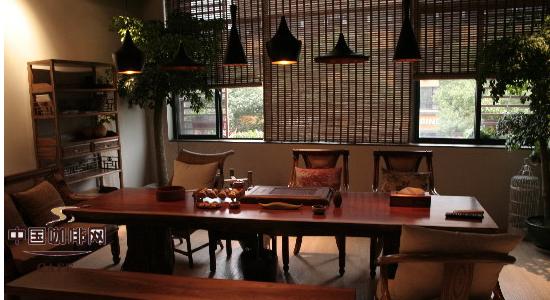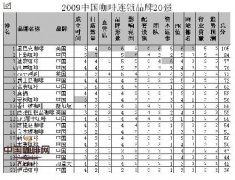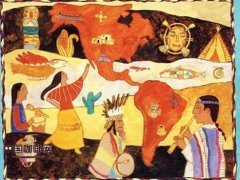Cafes are springing up all over China, the current situation of Chinese coffee

The cafe culture that appeared in Shanghai a hundred years ago during the concession era has shown increasing signs of rebirth in recent years. According to the Shanghai Food Association, there are now more than 12,000 stores selling coffee in Shanghai, with nearly 100000 employees.
Reporting by Chen Yingzhu
Shanghai special commissioner
Chinese people drink tea not only for their physical needs or traditional culture, but also as a way to socialize, but coffee and cafes are bringing about significant changes in social culture.
The Shanghai Food Association recently released a report on "30 years of Shanghai Food", showing that in 2010, the coffee-based catering industry was second only to dinner restaurants in sales, accounting for 17.2% of the industry's total sales. But the profit of the coffee shop is as high as 16.37%, which is much higher than the 10.6% of the average profit of the entire catering industry.
The report is confirmed by cafes commonly seen in cities across China in recent years. The cafe culture, which appeared in the "concession era" a hundred years ago, has shown more and more signs of rebirth in recent years. The Food Association reports that there are now more than 12,000 stores concurrently engaged in coffee in Shanghai, with nearly 100000 employees.
Taiwan's duplex coffee industry, cross-strait coffee, has 560 stores across the mainland, and there are thousands of stores across the mainland, which are also combined with diversified Taiwanese brands such as Dio Coffee and Shangdao Coffee. Starbucks, the most famous American brand, has 100 stores in Shanghai alone, while another American brand, fragrant coffee, says it will increase the number of stores from dozens to 200 within three to five years.
Cafes blossom everywhere
Wang Jingying, president of Starbucks China, said last year that China has become Starbucks' largest market outside the United States, opening more than 200 stores a year and reaching 1500 by 2015.
Starbucks recently announced an increase in the price of coffee. Chen Ying, a 25-year-old Shanghai office worker who works in marketing, said: "just two more yuan!" The price of everything has risen. " She and her mother both drink coffee at home, while her father drinks more tea.
Chen Ying said that he usually drinks coffee when he goes out with friends and colleagues: "I feel that the atmosphere of the coffee shop is more suitable for young people, but the tea shop looks dull." She drinks Starbucks coffee once or twice a week, spending about 200 to 300 yuan a month (RMB, the same below, about S $40 to S $60).
In terms of shop opening and consumption scale, coffee, a western-style drink, has become popular all over China. Li Guoyan, deputy general manager of cross-strait coffee, told this newspaper that a high proportion of young to middle-aged people accept coffee. Like many desktop coffee shops on both sides of the strait, they sell coffee-based beverages, but he notes that in the past three years, the proportion of coffee sales in all kinds of drinks has doubled from 30% to about 60%. The company used 106.7 tons of coffee beans last year, an increase of 13.6 tons, or 14 percent, over the year before.
Industry insiders point out that the profit of beverages is already high, with the cost of materials for a cup of coffee worth 20 or 30 yuan less than 15%. Therefore, in the report of the Shanghai Food Association, it is not surprising that the profit of the coffee industry is "proud of group drinking". Li Guoyan even pointed out that the long business hours of duplex restaurants that mainly sell coffee also contribute to the growth of profits.
Li Guoyan analyzed that the duplex coffee shop can do five kinds of customer business: those who eat breakfast coffee; office workers or business guests who eat lunch; guests who drink afternoon tea, talk business, rest or simply surf the Internet; dinner parties; and midnight snacks for friends.
What is more noteworthy is the rapid formation of coffee culture and the changes it brings.
The business model of long-term supply has changed the living habits of urban residents, and it also shows that business and consumption are booming. Excluding alcohol consumption, social and leisure drinks have been tea-based in the past, with a variety of coffee options full of imaginative space.
Wang Xiaoyu, a cultural scholar at Tongji University, believes that coffee, as a beverage of choice, does not conflict with tea. He drinks more tea at home, but often goes to cafes when he goes out. One of the reasons is that there are fewer and fewer teahouses.
The difference between teahouses and cafes is the real cultural issue. "the caf é provides casual and comfortable space for public communication," he said. "it would be nice if the teahouse could be opened in a more public-like atmosphere. Chinese teahouses used to be the same, but now they are not. In turn, the functions of Chinese teahouses are assumed by cafes. The question now is how can the teahouse restore this function. "
Tea is China's "national drink", and many people are used to taking bottled tea with them to quench their thirst when they go out. For many consumers, coffee may still be one of the ways of urban life, and it has not yet risen to the status of necessities. Apart from the reasons of traditional habits, according to general understanding, coffee is not as healthy as tea. In addition, coffee is still a bit too expensive compared to low-and middle-income people.
People who study the history of the relevant industry believe that coffee is still inferior to tea art in Japan, other people who drink tea for health and health care are also gradually increasing, and the increasing sales of modern tea drinks show that tea itself is not in crisis. Therefore, although coffee is menacing, it is "western learning for use" at most, and it cannot shake the national foundation of the tea ceremony.
Important Notice :
前街咖啡 FrontStreet Coffee has moved to new addredd:
FrontStreet Coffee Address: 315,Donghua East Road,GuangZhou
Tel:020 38364473
- Prev

Analysis on Brand Competition of chain Coffee Shop Top 20 Coffee chains
Analysis of Brand Competition of chain Cafe 1. Starbucks, Costa system characteristics: location, a kind of city business district. Rents in the business district are growing rapidly, and peer-to-peer bargaining is common. The business model adopts a direct operation model, and the scope and speed of expansion are slow when there is no capital entry. 2. The joining fee and threshold of Shangdao coffee chain brand is too high, and the mode of first-tier city and first-tier city.
- Next

The coffee culture in Shanghai is multicultural and creative.
In the history of more than 160 years since Shanghai opened its port, there have been some famous old cafes. Among them, the ruins of the public coffee cafe, located on Duolun Road, Hongkou District, is a historical landmark where Mr. Lu Xun attended the youth gathering of the left-wing Writers' Union in the late 1920s. Since then, cafes in Shanghai have been associated with progressive literature. After more than 80 years, coffee culture has sprung up again in Shanghai. Coffee
Related
- What documents do you need to go through to open a coffee shop? coffee shop coffee shop certificate processing process
- How to purchase Coffee beans in small Cafe how to choose a suitable supplier for domestic Coffee supply Company
- How to drink Starbucks Fragrance White Coffee? how to make Australian White Coffee? what Italian coffee beans are recommended?
- The Story of Flora Coffee: the name of Flora Coffee Bean and the implication of the Flowers on Florna Coffee
- How much does a cup of coffee cost? How much is the profit of a cup of coffee? What is the profit of the coffee shop in a year?
- Yunnan small Coffee, known as "fragrant Coffee", introduces the characteristics of Alpine Arabica Coffee producing areas in Yunnan, China
- 2023 latest Starbucks full menu price list how much is a cup of Starbucks coffee what is better to drink the most popular hot and cold drinks recommended
- Starbucks different kinds of Coffee Price list Starbucks menu 2023 Top Ten Best drinks in Starbucks
- Starbucks Spring praise Comprehensive matching Coffee Bean theme Story Packaging implication and taste description
- The cost of a cup of coffee latte American coffee cost price and selling price

